
Sant Climent de Taüll, also known as the Church of St. Clement of Tahull, is a Roman Catholic church in Catalonia, Spain. It is a form of Romanesque architecture that contains magnificent Romanesque art. Other influences include the Lombard and Byzantine styles, which can be seen throughout the exterior and interior of the building. The church is a basilica plan structure with three naves, each of them with a terminal apse, and large columns separating the side naves. Connecting to the church is a slim bell tower that has six floors plus a base. The artwork inside the church include the famous mural paintings by the Master of Taüll, as well as the wooden altar frontal. These works of art represent different aspects of Christianity that can also be found in many other works of art. The most famous fresco, of Christ in Majesty in the main apse of the church, has been moved to the Museu Nacional d'Art de Catalunya in Barcelona.

Ulm Minster is a Lutheran church located in Ulm, State of Baden-Württemberg (Germany). It is currently the tallest church in the world and will likely remain so until the eventual completion of Sagrada Familia in Barcelona. The church is the fifth-tallest structure built before the 20th century, with a steeple measuring 161.5 metres (530 ft).

St. Mary's Cathedral, Tallinn is a cathedral church located on Toompea Hill in Tallinn, Estonia. Originally established by Danes in the 13th century, it is the oldest church in Tallinn and mainland Estonia. It is also the only building in Toompea which survived a 17th-century fire.

Turku Cathedral is the only medieval basilica in Finland and the Mother Church of the Evangelical Lutheran Church of Finland. It is the central church of the Lutheran Archdiocese of Turku and the seat of the Lutheran Archbishop of Finland, Tapio Luoma. It is also regarded as one of the major records of Finnish architectural history.

Saint Martin's Church of Valjala is a Lutheran church in Valjala, on the island of Saaremaa, Estonia. It is the oldest stone church on Saaremaa and possibly the oldest surviving church in Estonia.
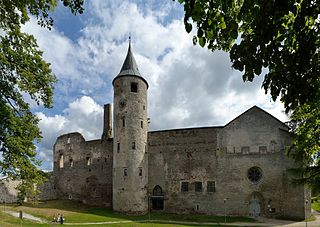
Haapsalu Castle is a castle with cathedral in Haapsalu, Estonia, founded in the thirteenth century as the seat of the Bishopric of Ösel-Wiek. According to legend, during full moons in August, an image of a maiden, The White Lady, appears on the inner wall of the chapel.

The cathedral of St. Bartholomew is a Gothic church located on the Main Square in Plzeň, Czech Republic. It was probably established together with the city around the year 1295. The church became a cathedral in 1993, when the Pilsner diocese was created. It was included on the list of National cultural monuments of the Czech Republic in 1995.

Pöide Church is located on Saaremaa island, in Pöide Commune, Saare County, Estonia.

St. Nicholas Church is a medieval former church in Tallinn, Estonia. It was dedicated to Saint Nicholas, the patron of the fishermen and sailors. Originally built in the 13th century, it was partially destroyed in the Soviet bombing of Tallinn in World War II. It has since been restored and today houses the Niguliste Museum, a branch of the Art Museum of Estonia, focusing mainly on ecclesiastical art from the Middle Ages onward. The former church is also used as a concert hall.

Växjö Cathedral is a cathedral in Växjö, Sweden. It is the seat of the Bishop of Växjö within the Church of Sweden. According to legend, the cathedral was founded by Saint Sigfrid of Sweden. The first stone church on the site, parts of which are incorporated into the current cathedral, was built in the 1160s. The cathedral has been much altered over time, and its appearance today is largely the result of a far-reaching restoration carried out in the 1950s under the guidance of architect Kurt von Schmalensee. Växjö Cathedral is a hall church with a western tower and a square choir. It was built on a location which was probably used as a marketplace during pre-Christian times. Very few of the cathedral's furnishings have survived from earlier centuries; most of the works of art adorning the cathedral date from the 20th or 21st centuries and many of them are made of glass.

The Co-Cathedral of Saint Nicholas in Prešov is one of the oldest and most important churches in Slovakia. External dimensions of concathedral are 54.7 meters in length, 34.45 in width. The height of indoor nave is 16 m and tower reaches a height of 71 meters. The temple is a Late Gothic hall-type church with three naves.

Karja Church is a medieval Lutheran church located in Linnaka village on Saaremaa island, Estonia. It is the rural church with the richest medieval stone sculpture decoration in all the Baltic states.

Bro Church is a medieval era Lutheran church at Bro on the Swedish island Gotland. Situated on what was possibly a pre-Christian sacred site, the presently visible church was built during the 13th century. Stylistically, its architecture shows a mix of Romanesque and Gothic elements. It still contains some medieval furnishings, including a baptismal font by Sigraf, and murals. The church belongs to the Väskinde parish in the Diocese of Visby of the Church of Sweden.
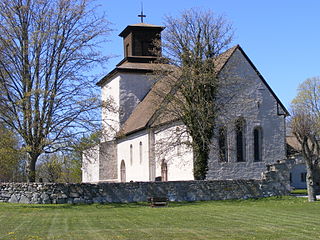
Vamlingbo Church is a medieval church on the Swedish island of Gotland, and one of the largest on the island. It lies in the Diocese of Visby.

Lye Church is a medieval church on Gotland, Sweden. The oldest parts of the church date from the last quarter of the 12th century, and the last major addition was the disproportionately large chancel, built during the second quarter of the 14th century by a workshop known by its notname as Egypticus. The workshop was also responsible for constructing the largest of the church portals, which is also decorated with Gothic stone sculpture. The tower portal contains sculptures attributed to the Romanesque sculptor Sigraf. The church has been little altered since the end of the Middle Ages. Lye Church contains the largest preserved set of medieval stained glass windows in the Nordic countries, and its interior is also decorated by medieval wall paintings, uncovered in the 1950s. The altarpiece is from 1496, and the church also contains a triumphal cross from the same period.

The Protestant Amandus Church in Freiberg am Neckar, Germany, is a late Gothic fortified former village church. Apart from the collegiate church in Bad Urach it is the only church of that name in Baden-Württemberg. Situated on a hill above the old village centre, it is notable for a diversity of architectural styles and for its paintings and organ.
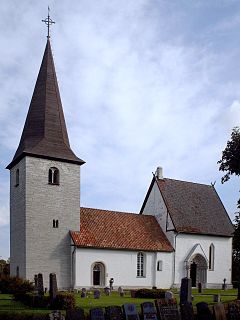
Halla Church is a medieval church in Halla on the Swedish island Gotland. It is part of the Diocese of Visby.

The Carmelite Monastery Church of the Annunciation at Hirschhorn in Hesse, Germany dates from 1406, when the Lord of Hirschhorn established a Carmelite monastery there. Its architectural style is late Gothic. In 1803, the monastery was dissolved, and the church deconsecrated. The church fell into ruin; but it has since been rebuilt, and it was reconsecrated in 1910.
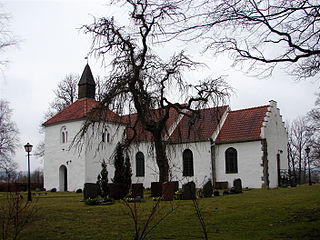
Stehag Church is a medieval church in Stehag, Scania, Sweden. It belongs to the Church of Sweden. It contains Romanesque church murals with royal donor portraits.
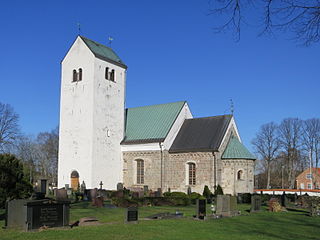
Vä Church, sometimes also called Saint Mary's Church in Vä is a well-preserved Romanesque church in Vä, in the southern Swedish province of Scania. It belongs to the Church of Sweden and is a listed building. It was built in the early 12th century, at a time when Scania was part of Denmark. The building was commissioned by a member of the Danish royal family, probably Queen Margaret Fredkulla. The church originally consisted of a nave, a chancel with an apse and two western towers. Quite soon after being finished, it was donated to Premonstratensian monks who used it as the church of their monastery until 1213. It simultaneously functioned as the parish church of Vä. At the end of the Middle Ages, a third tower was built, and in 1593 the building was enlarged. At the beginning of the 19th century, the western towers were demolished. A major restoration was carried out in the 1960s.




























